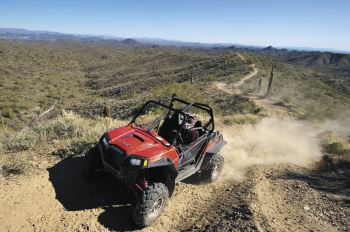 By now you've heard of and even seen pictures of Polaris' newest creation, the RZR XP 900. We gave you a sneak peek of the machine (www.dirttoysmag.com on Feb. 9 news update) just after we rode it in late January.
By now you've heard of and even seen pictures of Polaris' newest creation, the RZR XP 900. We gave you a sneak peek of the machine (www.dirttoysmag.com on Feb. 9 news update) just after we rode it in late January.
Even weeks later, the ride is still fresh in our minds. The vehicle was that impressive.
When talking about the new Polaris RZR XP 900, it's tempting to say something like, "The RZR XP 900 is like the RZR S 800 on steroids" or "The RZR XP 900 is a beefed up RZR S 800."
After all, the RZR XP 900 has more power, offers an excellent ride and really does outshine the RZR S 800. And that's saying something because the RZR S 800 is no slouch.
Polaris officials knew the analogies would be flying after we rode the RZR XP 900, so they were quick to nip a few in the bud. Roger Hapka, director of product planning at Polaris said, "[The RZR XP 900] is not a RZR S with a bigger motor. This is a performance vehicle."
And lest anyone dis on the rest of the RZR lineup, Craig Scanlon, Polaris' director, ORV sales and marketing, said, "We were looking to add to our family, not take anything away from our existing models."
Okay, we get it. And after getting a little seat time in the RZR XP 900 in the desert north and west of Phoenix, AZ, in the Hieroglyphic Mountains, we agree that this vehicle is a whole new animal. Yes, it shares the RZR name and yes it does have a bigger motor and yes it looks much like the RZR S 800 but there are few similarities once you dig deeper.
Aaron Deckard, senior project engineer at Polaris, pointed out that indeed, there aren't many components that are the same when comparing the RZR 8 and RZR 9 and, in fact, some things have been upgraded on the rest of the RZR lineup after they were introduced on the XP 900. "General seating and ergos are the same," Deckard said. "We also made improvements to all the RZR family due to development issues that came up when we worked through the high power delivery from the XP. An all-new front drive design, for example."
Power Vs. Handling
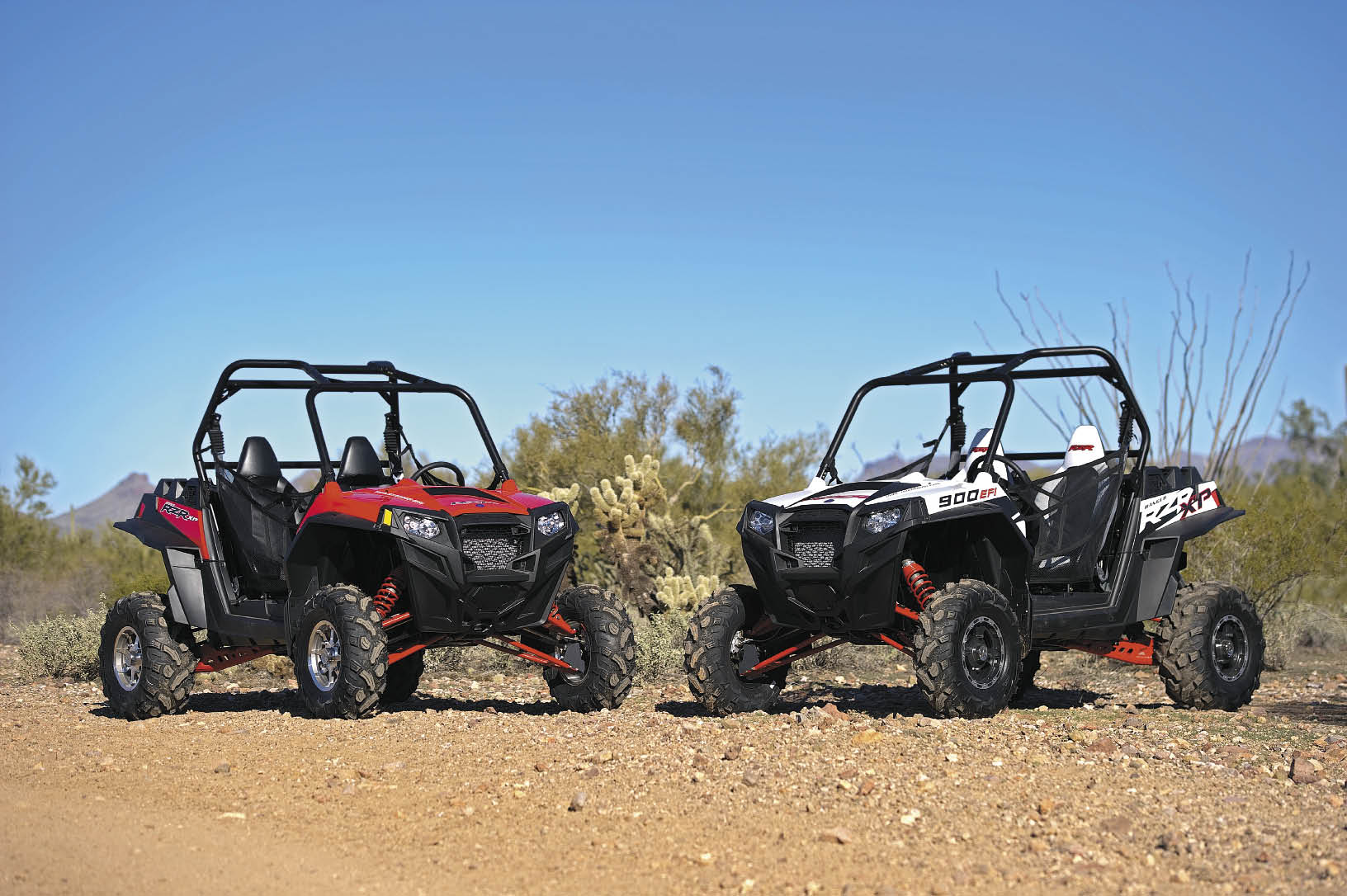 When you've got a vehicle like the RZR XP 900 that was so anticipated by motorheads everywhere and one that is bound to be as popular as this vehicle will be, it might be a tough choice on where to start. And once you ride the RZR XP 900 it might be even tougher as to what impressed you the most.
When you've got a vehicle like the RZR XP 900 that was so anticipated by motorheads everywhere and one that is bound to be as popular as this vehicle will be, it might be a tough choice on where to start. And once you ride the RZR XP 900 it might be even tougher as to what impressed you the most.
You can have a great powerplant but if the ride is crappy, who cares if you've got the power? It might be like riding a wild bronc where you have little control of the handling and the vehicle is doing what it wants, not what you want. Conversely, you can have a great ride but if the power is lacking, well, wave to all your buddies as they pass you on the way to the trails or on the dunes.
What makes the RZR XP 900 so exciting is an ideal blend of both power and handling. It's smooth both in power and ride.
Let's look at the power first.
Pro Star Engine
If you love the RZR 800 engine, you're really going to love the RZR 900. What's not to love? The 900 is powerful, responsive and has 34 more horsepower than the Polaris 800.
When you ride the 800 and then the 900, it's nearly impossible to miss the additional horsepower. Wait, scratch that. It is impossible to miss an extra 34 hp. And that would be in all riding conditions.
Designed from scratch and specifically for the RZR XP, the ProStar 900 twin EFI powerplant can brag about being the industry leader in horsepower with 88 ponies. That's compared to the 54 hp of the RZR S 800. It's not like the 800 is a slouch of a motor. It is plenty powerful, but now there's a 900 for those who want even more horses.
Dual overhead cams with high flow ports and fewer moving parts, a 180-degree crankshaft configuration, 750w charging system and four valves per cylinder are just a few highlights of the ProStar 900. The engine's official displacement is 875cc, 115 more than the RZR 800's displacement.
The countermotion of the pistons reduces the amount of rotating mass inertia that is counteracted with the balance shaft. That means less vibration from the bigger engine.
The 46mm throttle bodies are as close to the intake as possible, providing instant throttle response. According to Deckard, "It's not just that the throttle bodies are close. The air path into the combustion chamber is straight-no bends." That's unlike other RZR models where there is a bend in the hose leading to the combustion chamber. "When a throttle body opens the air has a straight path so the engine has the available air volume it needs. There is no hesitation because the air is right there. Maximizing space for a clean side air reserve is great for throttle response. Keeping them close improves flow and allows a very straight path to the combustion chamber."
The Hieroglyphic Mountains offer an incredible variety of riding conditions from dirt to sand to dry washes with their hard edges and loose gravel to baked-under-the-blazing-sun hardpack to rocks. The only kinds of riding surfaces we didn't find was deep sand like on the dunes and Moab-like slickrock. We can only imagine what that kind of stock power would be like on the dunes (we'll find out this summer).
From a power standpoint, the ProStar 900 was impressive in all those riding conditions. Powering through loose-fill washes was a blast because of the instant throttle response. Need to goose the gas a little to get out of a tight spot? The power was right there. Climbing was easy as we scaled one ridge in the mountains that wasn't necessarily long and steep but steep and long enough to see what the ProStar 900 had to give. We never tapped out the power.
Exhausting
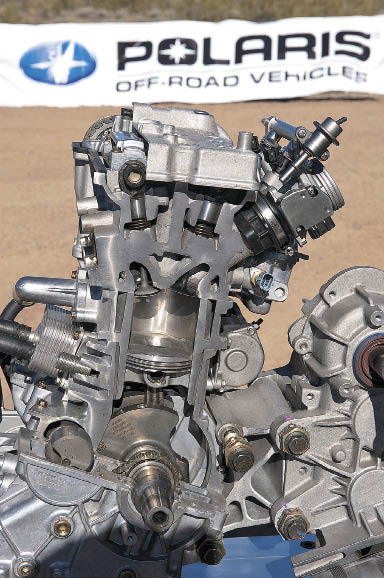 The exhaust system was also designed to help take full advantage of the power being created in the 875cc engine. It was tuned for performance as well as sound and maximum torque. Deckard provided a little more detail on the exhaust system, which exits out the front of the engine. "We designed and tuned the length of the primary headers and the collector location with computer models and then further tuned in the dyno environment," he said. "This design was to maximize power while increasing the optimal torque curve. The collector was placed based on the pressure wave generated by the motor. In order to package this exhaust, it was arranged in the vehicle the way it was."
The exhaust system was also designed to help take full advantage of the power being created in the 875cc engine. It was tuned for performance as well as sound and maximum torque. Deckard provided a little more detail on the exhaust system, which exits out the front of the engine. "We designed and tuned the length of the primary headers and the collector location with computer models and then further tuned in the dyno environment," he said. "This design was to maximize power while increasing the optimal torque curve. The collector was placed based on the pressure wave generated by the motor. In order to package this exhaust, it was arranged in the vehicle the way it was."
Getting The Power To The Wheels
Of course, we all know it doesn't matter how good the power is if it's not getting to the ground. What a waste it would be to let any of the ProStar 900's 88 horses go unused just because of an inefficient drive system. But to get that kind of power to the ground required a good design and good, efficient parts in the drive system.
To help accomplish that, Polaris turned to the snowmobile market and designed its clutches after what is used on sleds, which can produce up to 160 hp plus in stock form. "Snowmobile clutches are designed for a lot of power," Deckard explained. "This is the most power we've ever had to put through a set of clutches on an ORV so we looked to snowmobile clutching."
For starters, Polaris had to design a belt that could take the heat-literally-that would be produced from the clutches, so a new compound is being used on the RZR 9's belt. The belt is the strongest belt Polaris makes, Deckard said. "It's stronger than any snowmobile belt we make." There is also a new stronger spider-not the same spider used in snowmobile clutches-specifically designed for the RZR XP 900. "We completely redesigned the spider for much more strength due to the large torque pulse in this motor and the extra power," Deckard explained. "We wanted the spider to be stiffer and have more surface area for the wider buttons. We started with the snowmobile-style spider and then took it to the next level."
Other highlights of the clutches include: fly weights that are bushed, wider weights to stay flat on the rollers and a fixed center to center distance from the primary to the secondary. The fixed center prevents the clutches from flexing as can happen in a snowmobile application, which reduces wear and creates more heat on the belt. The center to center distance is 10.5 inches. Deckard also pointed to zero lash matched buttons with three times the surface area.
The clutches are just part of a new compact transmission. Besides the obvious goal of getting the power to the wheels, Polaris also aimed to minimize driveline noise with the new CVT.
Commenting on the CVT, Deckard said, "The newly-designed transmission eliminates the rear axle ring and pinion set in exchange for a beefy helical spur gear-to-gear drive. It's very compact and has increased efficiency due to the gear-to-gear design as well as no right angle drives."
Also, the chain tensioner never needs adjustment because it has a self-adjusting hydraulic chain tensioner.
What About The Ride?
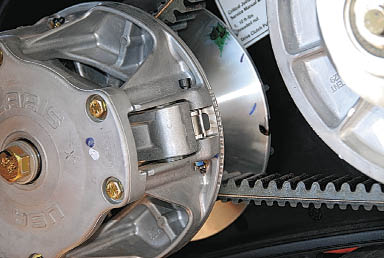 We think every bit as impressive as the power delivery is the ride, courtesy of a suspension system that has also been designed to handle the increased horsepower. Out front there's the dual A-arm front suspension with 13.5 inches of travel (1.5 inches more than the RZR S) and chromoly high carbon steel upper arms. Two-inch Fox Podium X 2.0 reservoir shocks which are compression and pre-load adjustable are on all four corners. On the rear is a 3-link trailing arm long travel Independent Rear Suspension where the 3-link design consists of two extra long radius rods and a far forward-connecting trailing arm. How it works is the trailing arms connect to swivel joints in the chassis which provide superior strength and 14 inches of travel. Combined, the front and rear suspension, along with the overall vehicle design, give the RZR XP 900 13 inches of ground clearance, which is 1.5 inches more than the RZR S and an impressive 3 more inches than the RZR 800. That clearance really comes into play when you're riding the rutted out trails and rock-littered washes we tested the RZR XP 900 on. We never hit anything lying on the ground and we never bottomed out.
We think every bit as impressive as the power delivery is the ride, courtesy of a suspension system that has also been designed to handle the increased horsepower. Out front there's the dual A-arm front suspension with 13.5 inches of travel (1.5 inches more than the RZR S) and chromoly high carbon steel upper arms. Two-inch Fox Podium X 2.0 reservoir shocks which are compression and pre-load adjustable are on all four corners. On the rear is a 3-link trailing arm long travel Independent Rear Suspension where the 3-link design consists of two extra long radius rods and a far forward-connecting trailing arm. How it works is the trailing arms connect to swivel joints in the chassis which provide superior strength and 14 inches of travel. Combined, the front and rear suspension, along with the overall vehicle design, give the RZR XP 900 13 inches of ground clearance, which is 1.5 inches more than the RZR S and an impressive 3 more inches than the RZR 800. That clearance really comes into play when you're riding the rutted out trails and rock-littered washes we tested the RZR XP 900 on. We never hit anything lying on the ground and we never bottomed out.
Deckard explained that by maximizing the distance of the XP's arms, Polaris was able to maximize the angle of the CV. "Normally, CV angles are the limiting factor in how much suspension travel a vehicle can have," he said. "With the 3 link we have the ability to place suspension hard points on the chassis to maximize the use of our CV angles and get more bang for the buck. We only get so much CV angle so we found a way to optimize it to get more suspension travel."
In talking about the RZR 9's suspension, Kevin McNutt, program leader at Polaris, said, "We think a little bit of scrub is a good thing." Deckard added, "A little bit of camber is a good thing. Scrub is just a result of camber. Having camber change throughout the travel not only slightly increased track width during cornering, which adds stability, but it also keeps the contact patch of the tire on the trail for less sidewall roll and better out-of-corner acceleration."
As Deckard pointed out, the XP 900 has 44 percent less scrub than a RZR S. "It is a fine balance between cornering performance and straight line handling," he said.
Stretching It Out
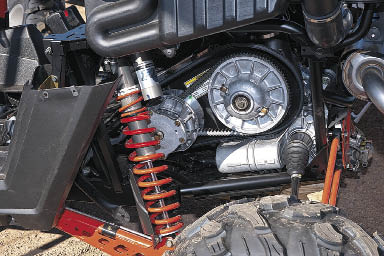 While not as long as the RZR 4 800, the XP 900 wheel base is nearly 4.5 inches longer than the RZR S 8. That design helps Polaris control the pitch inertia of the vehicle and that, in turn, contributes to the stability and predictability of the handling. That was also evident on the variety of terrain on the Arizona ride. One thing we really like about Polaris vehicles is the predictability of the ride. Once you get used to it, you know what the vehicle is going to doing in different situations.
While not as long as the RZR 4 800, the XP 900 wheel base is nearly 4.5 inches longer than the RZR S 8. That design helps Polaris control the pitch inertia of the vehicle and that, in turn, contributes to the stability and predictability of the handling. That was also evident on the variety of terrain on the Arizona ride. One thing we really like about Polaris vehicles is the predictability of the ride. Once you get used to it, you know what the vehicle is going to doing in different situations.
In talking about the pitch control, Deckard said, pitch control is about taming a vehicle's tendency to transfer mass about the CG of the vehicle fore and aft while riding over rough terrain. Lengthening the wheel base adds longitudinal leverage which helps control bucking."
What we found, in addition to the predictability of the RZR XP 9, is that if the back end did get a little "happy" and came off the ground or whatever, it settled right down. And it wasn't like it was a thud but a much softer landing. Of course, having the engine in the rear of the vehicle helps due to the weight, but the length of the wheel base also makes a difference. We never felt out of control in the RZR XP nor did it ever feel tippy.
Another advantage of the increased wheel base as well as "having rubber on all four corners" as Deckard describes it, is that you can take all the weight of the vehicle and transfer it inward. "So no matter how you load the vehicle, you can put weight in and it won't change the balance of the vehicle more than 4 percent."
While you're digesting all of that, let us point out we haven't even touched on the factory-first LED headlights, improved steering, new cooling system, bigger charging system, new high-strength steel frame, skid plate and the list goes on.
Sometimes we might shun something new or tell ourselves, "Well, it's a first year model, I'll wait a year so they can work the bugs out and then I'll see how it is after that."
We think Polaris nailed it the first time out of the chutes with the RZR XP 900.
2011 Polaris RZR XP 900
Engine: Twin-cylinder 4-stroke
Displacement: 875cc
Fuel System: Electronic Fuel Injection
Cooling: Liquid
Fuel Capacity: 7.25 gallons
Final Drive: Shaft
Transmission: Automatic PVT with P/R/N/L/H
Drive System: On-Demand True AWD/2WD
Front Suspension: Dual A-arm, Fox Podium X 2.0 compression-adjustable reservoir shocks, 13.5 inches travel
Rear Suspension: Trailing arm, with anti-sway bar, Fox Podium X 2.0 compression-adjustable reservoir shocks, 14 inches travel
Brakes: 4-wheel hydraulic disc with dual-bore calipers
Wheels: Cast aluminum
Front Tires: 27x9-12; ITP 900 XCT
Rear Tires: 27x11-12; ITP 900 XCT
Wheelbase: 81.4 in.
Length: 108.4 in.
Width: 64 in.
Height: 73 in.
Ground Clearance: 13 in.
Dry Weight: 1,190 lbs.
MSRP: $15,999

